Projects
Biomembrane
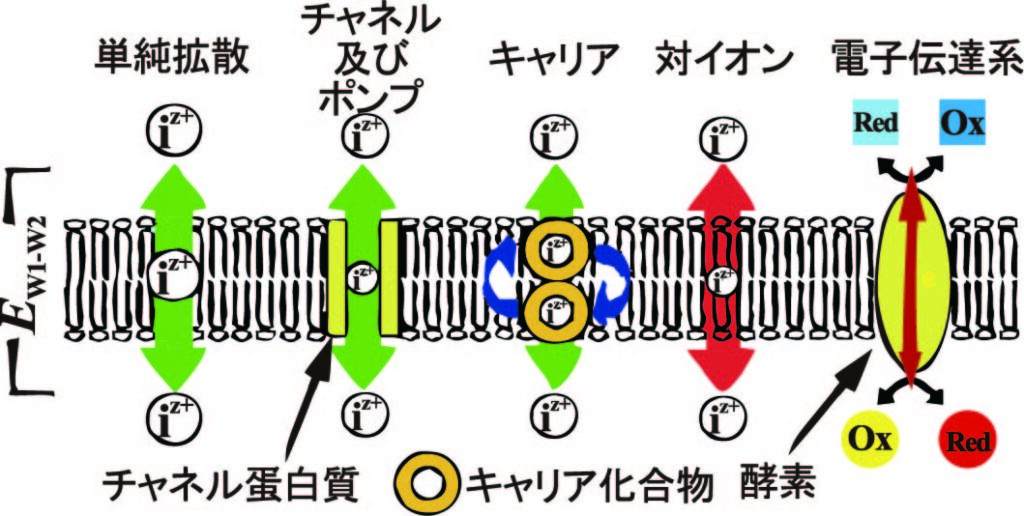
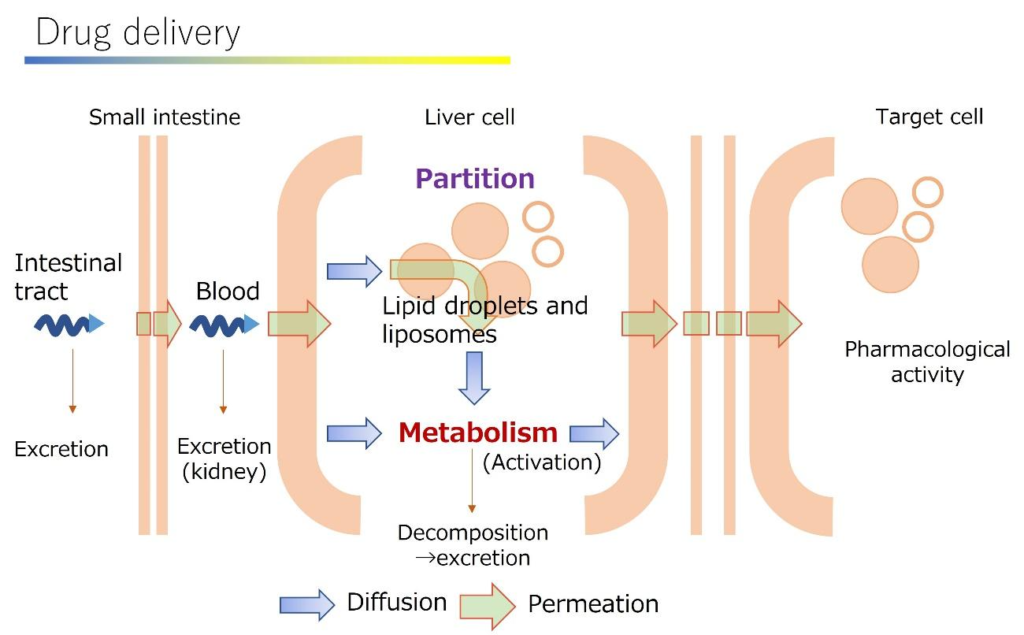
The body of an organism is constructed from many cells. According to the simplification from a physicochemical point of view, a cell was separated two aqueous solutions by the cell membrane. In addition, there are various other biomembranes in living organisms, which separate aqueous solutions of different composition. Membranes are sites to generate energy and materials by controlled mass transport between aqueous solutions of different compositions. Channel proteins on biological membranes play an important role in regulating mass transport. The transport of molecules and ions across the membrane is investigated from the viewpoint of physical chemistry. For example, the interior of an organism is composed of many membrane-separated tissues. The drug ingested by mouth must pass through many membranes to reach the target cell. Therefore, membrane permeation is the basis of drug transport in living organisms. We are developing analytical models and theories of drug transport.
Keywords: bilayer lipid membrane, ion transfer, ion channel, membrane bind enzyme, delivery, bioconcentration, anesthesia, liner free energy relationship
Ion Transport across Bilayer Lipid Membranes in the Presence of Tetraphenylborate
T. Naruse, Y. Yamada, K. Sowa, Y.Kitazumi, O. Shirai
Anal. Sci., 38 683 (2022)
DOI: 10.1007/s44211-022-00086-7
Spontaneous Accumulation of Cesium Ions Based on the Membrane Potential Using a Selectively Permeable-Polyvinyl Chloride Capsule Containing Concentrated Potassium Ions and Zeolites
M. Motoike, K. Kimura, Y. Kitazumi, K. Kano, O. Shirai
J. Electroanal. Chem., 871 114300 (2020)
DOI: 10.1016/j.jelechem.2020.114300
Permselectivity of Gramicidin A Channels Based on Single-channel Recordings
T.Yamaguchi, Y. Kitazumi, K. Kano and O. Shirai
Electroanalysis, 32, 1093-1099 (2020)
DOI: 10.1002/elan.201900684
Neurons
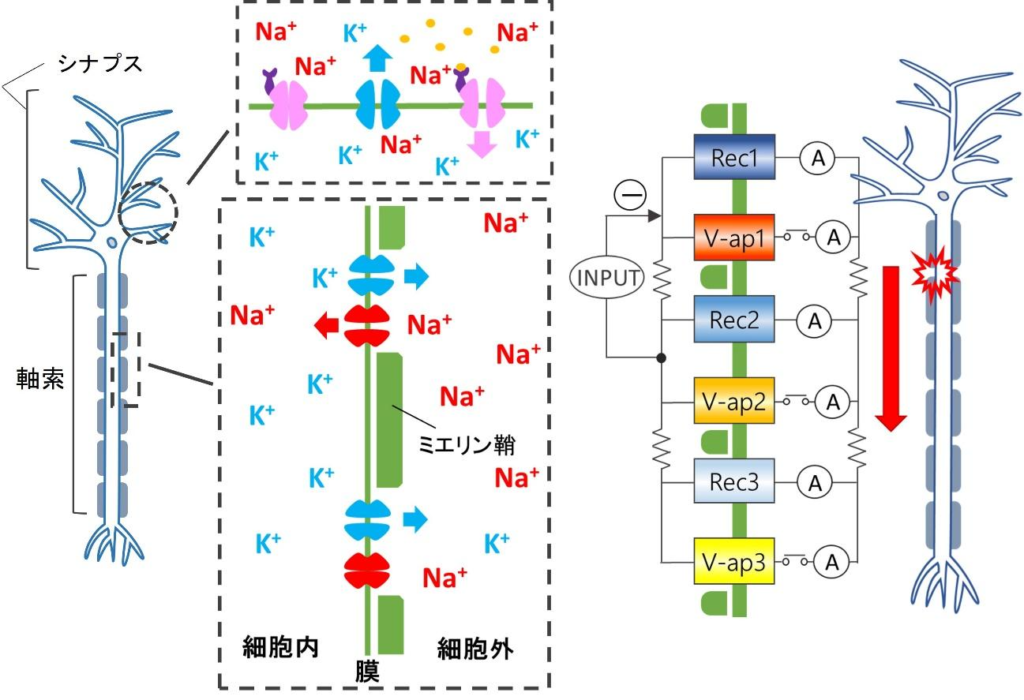
In living organisms, various information is transmitted within and between cells. The information includes neurotransmitters and electrical signals. For example, when a neuron is stimulated, the membrane potential changes. The fluctuation of the membrane potential spreads to the end of the axon and then induces the release of neurotransmitters. The chemicals excite the next neuron. We are investigating the mechanisms of information transmission in the cell, such as the propagation of membrane potential changes and the conversion of information from neurotransmitters to membrane potential changes. Cell membranes and electrolyte solutions inside and outside the cells were focused as the elemental components, and we are conducting physicochemical analyses not on real cells but on model cells. The model cells are constructed and assembled according to the phenomena to be analyzed and investigated how electrical signals are transmitted on and between cells. Additionally, model cell membranes are employed to elucidate the mechanism of excitation by neurotransmitters.
Keywords: model cells, neurotransmission, intercell communication, synchronization phenomena
Severe Problems of the Voltage-Clamp Method in Concurrent Monitoring of Membrane Potentials
M. Kaji, Y. Yamada, Y. Kitazumi and O. Shirai
Electroanalysis, 34 1299 (2022)
DOI: 10.1002/elan.202100508
Electrical cell-to-cell communication using aggregates of model cells
I. Kasai, Y. Kitazumi, K. Kano, O. Shirai
Phys. Chem. Chem. Phys. 22 (2020) 21288-21296
DOI: 10.1039/C9CP06777A
Chemical sensors
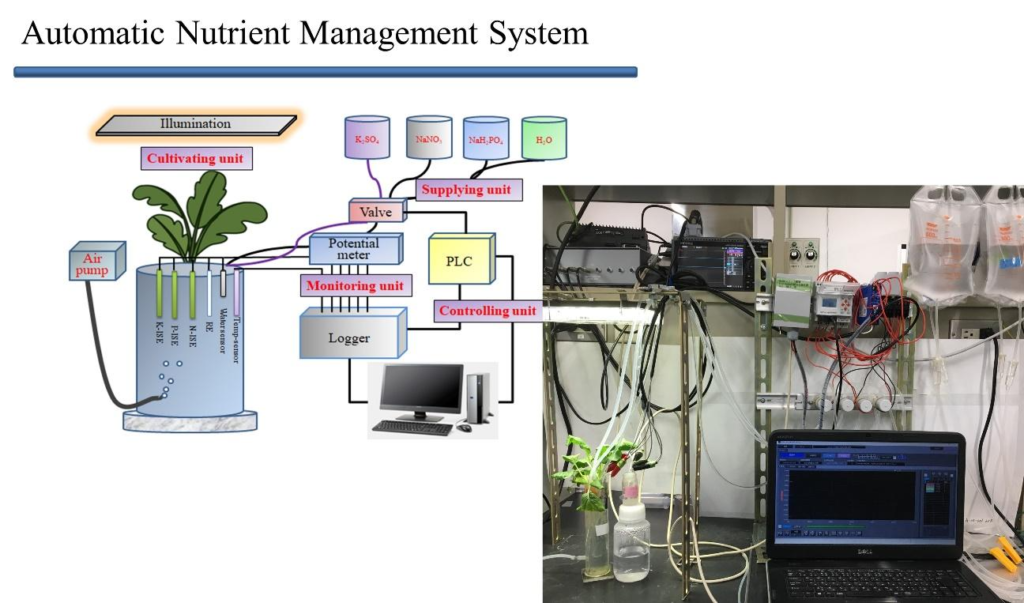
Plants grow by converting water and carbon dioxide into organic compounds through photosynthesis. Nutrients essential for plant growth are called fertilizers, and fertilization is essential for healthy plant growth. Fertilizers become ions in an aqueous solution and are absorbed by plant roots. On the other hand, excessive fertilization not only hinders plant growth but also causes environmental pollution. Therefore, it is important to measure the concentration of fertilizer in the field where plants are grown. When a membrane, through which only a certain ion can permit, is brought into contact with an aqueous solution, a membrane potential corresponds to the concentration of the ion. This is the fundamental principle of the liquid membrane-type ion sensor. We are researching sensors to measure the concentration of various fertilizer components under plant growth conditions. The amount of fertilizer required during the plant growth stage is investigated to realize more efficient plant growth and optimize fertilizer application. Ion sensors mainly the various ions necessary for the plant growth are developing.
Keywords: Nernst equation, nutrient sensor, soil sensor, pH sensor, reference electrode
Electrochemical consequtive detection of NO2– and NO3–
K. Kitao, K. Sowa, Y. Kitazumi, O. Shirai
J. Electroanal. Chem. 939, 117429 (2023)
DOI: 10.1016/j.jelechem.2023.117429
Pollution Control of Nitrate-Selective Membrane by the Inner Solution and On-site Monitoring of Nitrate Concentration in Soil
E. Nakao, Y. Kitazumi, K. Kano and O. Shirai
Anal. Sci., 37 887 (2021)
DOI: 10.2116/analsci.20p323
Enzyme electrode

Enzymes, which are biocatalysts, play a very important role in global material cycles and respiratory metabolism in living organisms. Enzymes can function most efficiently at room temperature and pressure due to their advanced functions acquired during evolution. Therefore, enzymes are being actively studied worldwide as a trump card for building a sustainable future society.
We are conducting bioelectrochemical studies focusing on redox enzymes, which account for about 30% of all enzymes. Redox enzymes catalyze oxidation and reduction reactions, which are accompanied by electron transfer. Since electron transfer can be captured as an electric current, we can construct “enzyme electrodes (enzyme-functional electrodes)” by combining redox enzymes, which are biomaterials, with electrode materials.
The enzyme electrode undergoes bioelectrocatalysis, in which the enzyme reaction and the electrode reaction are conjugated. This reaction enables material-energy conversion with controlled electron transfer, and is known as the basic principle of blood glucose level sensors, which have a huge market all over the world.
This reaction appears simple at first glance, but it is actually very complex. It requires not only redox enzymes, electrode materials, and mediators that promote electron transfer, but also three-dimensional electrode design and electrode interface control. In particular, there are many unresolved phenomena regarding the reaction mechanisms at and near the electrode surface. Therefore, we are working to thoroughly understand the fundamentals of enzyme electrode reactions from the viewpoint of bioelectrochemistry, and to link this to biomimetics (biomimetic technology).
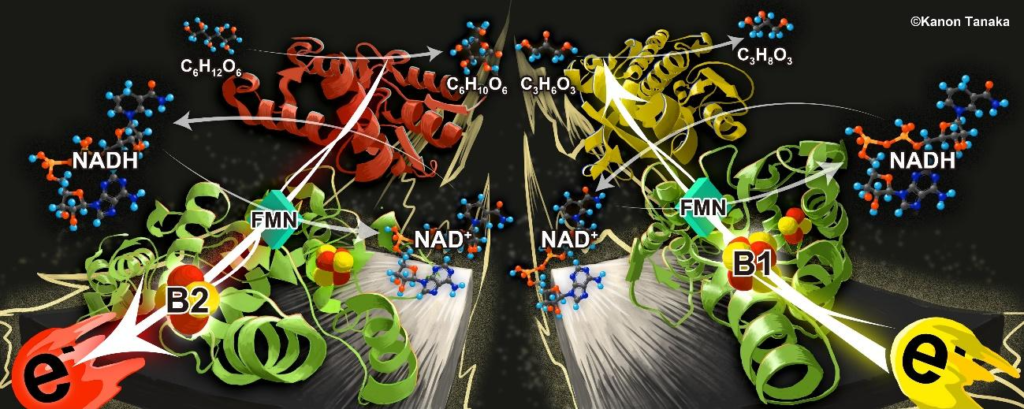
Keywords: bioelectrocatalysis, redox enzyme, electron transfer, electrode material, porous material, electrode design, mediator, electric double layer, enzyme adsorption simulation, reaction analysis
Effects of N-linked glycans of bilirubin oxidase on direct electron transfer-type bioelectrocatalysis
Y. Suzuki, A. Ito, K. Kataoka, S. Yamashita, K. Kano, K. Sowa, Y. Kitazumi and O. Shirai
Bioelectrochemistry, 146 108141
DOI: 10.1016/j.bioelechem.2022.108141
Inhibition of direct-electron-transfer-type bioelectrocatalysis of bilirubin oxidase by silver ions
T. Makizuka, K. Sowa, O. Shirai and Y. Kitazumi
Anal. Sci., 38 907
DOI: 10.1007/s44211-022-00111-9
DET-type enzyme

Redox enzymes are involved in respiration and metabolism in living organisms and have a high degree of control over electron transfer. Therefore, electron transfer pathways in catalytic reactions are strictly defined, and in general, small redox mediators have been essential for electron transfer with enzymes.
However, some rare enzymes (about 30 species, or 0.01% of all enzymes reported in the world) have been discovered to be able to transfer electrons directly to and from electrodes, which are solid materials. This enzyme is academically called a direct electron transfer (DET)-type enzyme, and we also use the term “conductive enzyme” to indicate that it has conductive properties.
By modifying electrode materials with conductive enzymes, their catalytic function can be easily imparted to electrode materials. In addition, the simplest enzyme-functional electrode can be constructed, consisting only of an enzyme and an electrode, which enables excellent energy conversion efficiency and a high degree of freedom in design.
We have studied 10 conductive enzymes, among which we present our work on fructose dehydrogenase (FDH), which is known as a model enzyme because its activity is more than 10 times higher than average. We have also produced a wide variety of mutants by enzyme engineering and clarified their bioelectrochemical properties. However, because of its membrane-bound nature, X-ray crystallographic analysis has not been successful for many years, making structural biology difficult to study. Recently, however, we have succeeded in elucidating the three-dimensional structure of this enzyme using cryo-electron microscopy, a Nobel Prize-winning technique, and this has led to a major breakthrough.
We are currently working on an ambitious project to create tailor-made conductive enzymes using “structural bioelectrochemistry,” which is a fusion of structural biology, enzyme engineering, and electrochemistry. We are aiming to create strategic new conductive enzymes by using alcohol dehydrogenase (ADH) and aldehyde dehydrogenase (ALDH) as template enzymes, and by taking a novel approach in silico and in vitro.
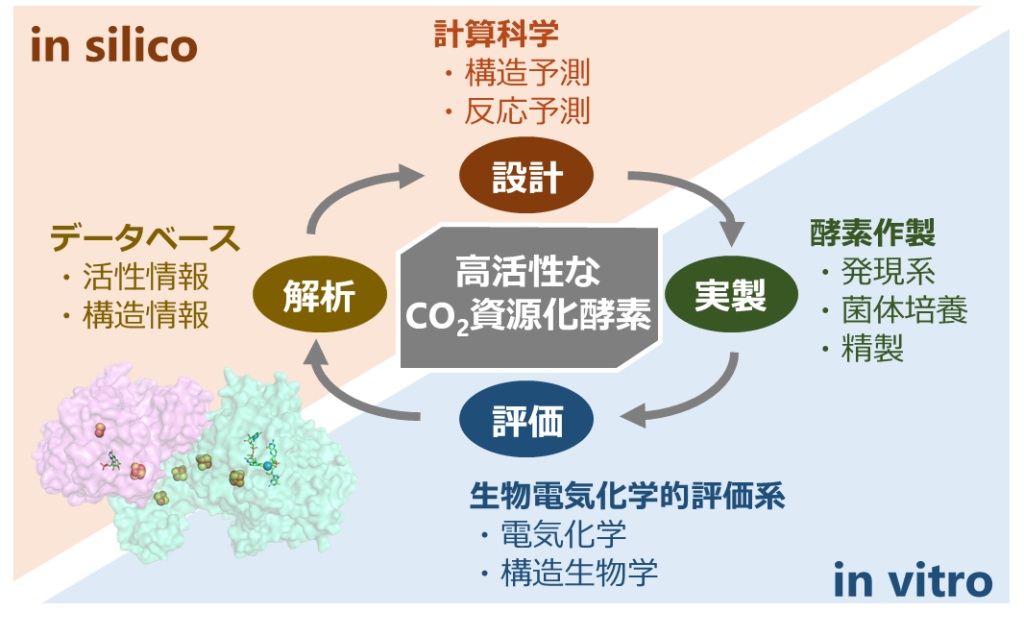
Keywords: DET-type enzyme, conductive enzyme, cryo-EM, in silico analysis, machine learning
Multiple electron transfer pathways of tungsten-containing formate dehydrogenase in direct electron transfer-type bioelectrocatalysis
T. Yoshikawa, F. Makino, T. Miyata, Y. Suzuki, H. Tanaka, K. Namba, K. Kano, K. Sowa, Y. Kitazumi and O. Shirai
ChemComm, 58 6478
DOI: 10.1039/D2CC01541B
Structural and Bioelectrochemical Elucidation of Direct Electron Transfer-type Membrane-bound Fructose Dehydrogenase
Y. Suzuki, F. Makino, T. Miyata, H. Tanaka, K. Namba, K. Kano, K. Sowa, Y. Kitazumi and O. Shirai
ChemRxiv, 14 March (2022)
DOI:10.26434/chemrxiv-2022-d7hl9
Essential Insight of Direct Electron Transfer-Type Bioelectrocatalysis by Membrane-bound D-Fructose Dehydrogenase with Structural Bioelectrochemistry
Y. Suzuki, F. Makino, T. Miyata, H. Tanaka, K. Namba, K. Kano, K. Sowa, Y. Kitazumi and O. Shirai
ChemRxiv, 25 July (2023)
DOI: 10.26434/chemrxiv-2023-8f5g4
Biomimetics
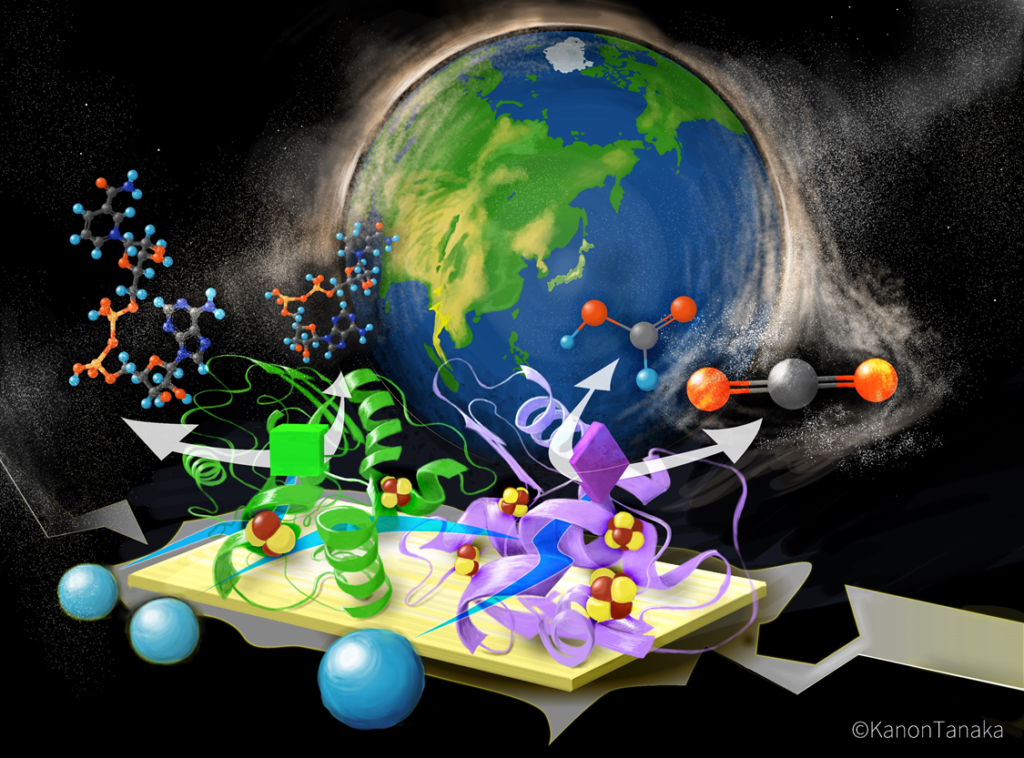
We aim to apply biomimetics, a technology that mimics advanced biological functions created by nature, to a wide range of fields in society. Catalytic reactions by redox enzymes involve electron transfer, so controlling electron transfer can lead to a variety of applications.
For example, electron transfer (giving electrical energy) can be applied to bioreactors, and the global goal of carbon neutrality by the year 2050 is to convert CO2 into a resource. To achieve this goal, bio-CCU (Carbon Dioxide Capture and Utilization), which is the bioconversion of CO2 to formic acid, can be realized by utilizing the highly efficient catalytic function of enzymes.
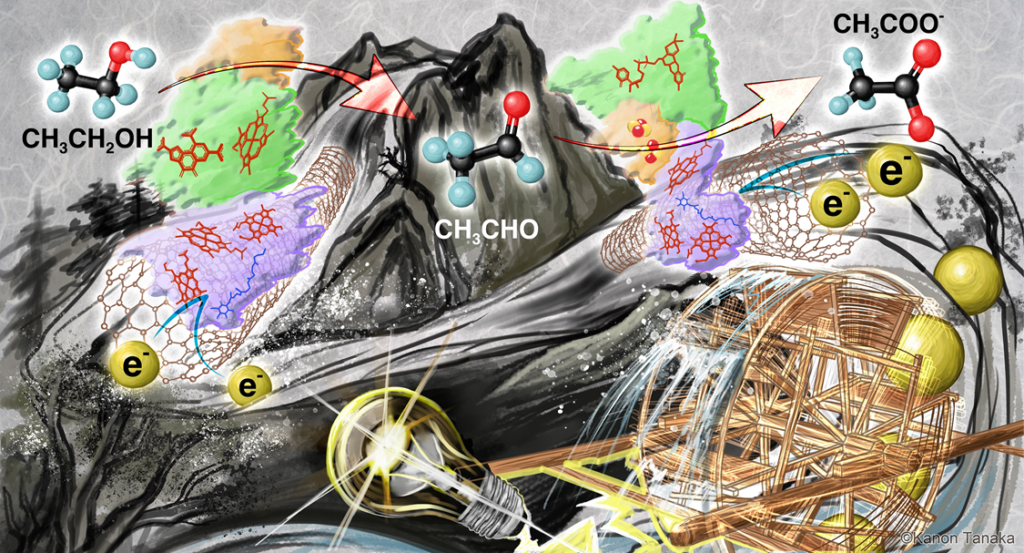
In terms of extracting electricity (extracting electrical energy), it can be applied to biofuel cells. For example, in the case of extracting electrical energy from glucose, it is theoretically possible to extract energy equivalent to 64 AA alkaline batteries from a bowl of white rice, making it an attractive next-generation power generation device. In addition, it can also generate electricity from hydrogen and ethanol, making it possible to use clean hydrogen or bioethanol as a fuel source.
We are also conducting applied research on artificial photosynthesis using light energy, microbial fuel cells that use microorganisms as enzyme bags, and salinity difference power generation that utilizes the function of electric eels.
Keywords: biosensor, biofuel cells, CO2 capture and utilization, artificial photosynthesis, microbial fuel cell, salinity difference power generation
Multiple electron transfer pathways of tungsten-containing formate dehydrogenase in direct electron transfer-type bioelectrocatalysis
T. Yoshikawa, F. Makino, T. Miyata, Y. Suzuki, H. Tanaka, K. Namba, K. Kano, K.Sowa, Y. Kitazumi and O. Shirai
ChemComm, 58, 6478. (2022)
DOI: 10.1039/D2CC01541B
Experimental and Theoretical Insights into Bienzymatic Cascade for Mediatorless Bioelectrochemical Ethanol Oxidation with Alcohol and Aldehyde Dehydrogenases
T. Adachi, T. Miyata, F. Makino, H. Tanaka, K. Namba, K. Kano, K. Sowa, Y. Kitazumi and O. Shirai
ACS Catalysis, 13, 7955 (2023)
DOI: 10.1021/acscatal.3c01962
Improvement in the Power Output of a Reverse Electrodialysis System by the Addition of Poly(sodium 4-styrenesulfonate)
Y. Yamada, K. Sowa, Y. Kitazumo, O. Shirai
Electrochemistry, 89, 467 (2021)
DOI: 10.5796/electrochemistry.21-00073
Videos
生体機能化学研究室 紹介動画
白井教授の研究紹介動画
北隅准教授の研究紹介動画
L-INSIGHTフェローの宋和助教の研究紹介動画